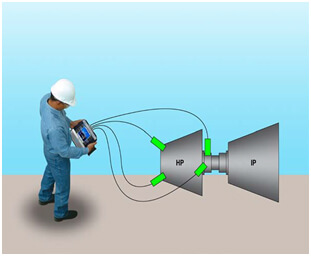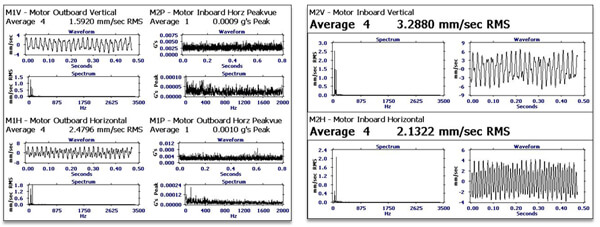 In an earlier post, Portable Vibration Analyzer-Human Centered Design Style, I mentioned four-channel analysis plus phase capability. I checked with Emerson’s Johan Van Puyenbroeck to explain what this means for process manufacturing maintenance professionals.
In an earlier post, Portable Vibration Analyzer-Human Centered Design Style, I mentioned four-channel analysis plus phase capability. I checked with Emerson’s Johan Van Puyenbroeck to explain what this means for process manufacturing maintenance professionals.
Multi-channel means the ability to collect data from multiple inputs. Triaxial (triax) accelerometers can measure vibration in the x-, y-, and z-axes and provide inputs for three of the channels.
 Here’s an example of a four-channel application—turbine inboard x-axis, turbine inboard y-axis, turbine outboard x-axis, and turbine outboard y-axis. The vibration signals are connected to a four-channel portable vibration analyzer, the CSI 2140 Machinery Health Analyzer. This type of measurement can monitor turbine start-ups/coast downs to look for typical problems such as shaft rubs, resonances, oil whirl, etc.
Here’s an example of a four-channel application—turbine inboard x-axis, turbine inboard y-axis, turbine outboard x-axis, and turbine outboard y-axis. The vibration signals are connected to a four-channel portable vibration analyzer, the CSI 2140 Machinery Health Analyzer. This type of measurement can monitor turbine start-ups/coast downs to look for typical problems such as shaft rubs, resonances, oil whirl, etc.
Natural frequencies where resonance can occur are directional. It is important to measure in the horizontal, vertical and axial directions. With four-channel analysis, all directions can be measured simultaneously.
Typically, it can take a little over a minute to collect the frequency spectrum data for the vibration analysis of all three measurement axes on a bearing, but this time has been reduced by a third with the CSI 2140. The more channels you can measure at one time, the more time saved to be able to check all the rotational equipment around the plant.
Route-based vibration analysis can be performed using single-, dual-, and even some four-channel analyzers requires placing sensors on machines multiple times per bearing just to get the recommended multi-directional measurements. The time to collect these vibration values is multiplied by potentially thousands of machines to analyze.
Here is an example of the data which can be collected with one measurement cycle via the four channels.
Different types of multi-channel analysis include simultaneous measurements on sleeve bearing machines such as orbits, comparative measurements between two separate measurements including coherence and cross-channel phase, and impact testing where frequency response functions/transfer functions are determined. For hammer impact tests, your hammer would be channel 4 and the other three channels would be 3 accelerometers or more conveniently, a single triax.





